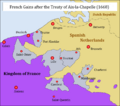War of Devolution facts for kids
The War of Devolution was a short war that happened between 1667 and 1668. It was fought between France and Spain. France, led by King Louis XIV, wanted to take over parts of the Spanish Netherlands and Franche-Comté. These areas are now mostly in modern-day Belgium, Luxembourg, and parts of France.
King Louis XIV said he had a right to these lands because of an old law called the Jus Devolutionis. This law was mostly used in Brabant, a region in the Spanish Netherlands. It said that when a parent died, their property should go to their children from a first marriage, not later ones. Louis XIV was married to Maria Theresa of Spain, who was the daughter of the previous Spanish king, Philip IV, from his first wife. Louis claimed that because Philip IV had died, Maria Theresa should inherit these lands, and since she was his wife, they should belong to France. However, Maria Theresa had given up her rights to Spanish lands when she married Louis, as part of her marriage agreement. Louis XIV argued that Spain had not paid her dowry (money given by the bride's family), so her giving up her rights was not valid. This disagreement led to the war.
Who Fought in the War?
- France, led by King Louis XIV.
- The Spanish Empire, which controlled the lands France wanted.
Later, three other countries formed an alliance called the Triple Alliance:
- England
- The Kingdom of Sweden
- The Dutch Republic (also known as the Netherlands)
These three countries did not join either side at first. They worried that if France became too strong, it would upset the balance of power in Europe. They also wanted to protect trade routes.
How the War Happened
King Louis XIV of France believed he had a strong claim to the Spanish Netherlands and Franche-Comté because of his marriage to Maria Theresa. In May 1667, French soldiers marched into the Spanish Netherlands, specifically into a region called Flanders. The Spanish army was not ready for this attack and was quite weak. The French quickly captured many towns and cities with little trouble.
The Triple Alliance (England, Sweden, and the Dutch Republic) saw that both France and Spain were getting weaker from the fighting. They realized this could be a chance for them to gain power or protect their own interests. They also knew that both France and Spain were important for trade across Europe and the world. So, they decided to step in and try to make peace.
The End of the War
After about a year of fighting, France and the Holy Roman Emperor Leopold I (who was also related to the Spanish king) started talking about peace. They agreed to divide some of the Spanish lands if the Spanish king died without an heir.
The War of Devolution officially ended with the Treaty of Aix-la-Chapelle in May 1668. In this treaty, France gave back most of the land it had captured in Franche-Comté. However, France was allowed to keep several important towns and areas in the Spanish Netherlands, including cities like Lille, Tournai, and Charleroi. This meant France gained some new territory, but not as much as Louis XIV had originally wanted. The Triple Alliance played a big part in pushing for this peace treaty.
Images for kids
-
Maria Theresa of Spain, whose unpaid dowry was used to justify the war
-
Johan de Witt, Dutch Grand Pensionary; he had to persuade Louis to withdraw, while keeping him as an ally
-
Louis XIV, ca 1661
-
French gains by Treaty of Aix-la-Chapelle: Louis returned Cambrai, Aire and Saint-Omer, but retained the rest
See also
 In Spanish: Guerra de Devolución para niños
In Spanish: Guerra de Devolución para niños






